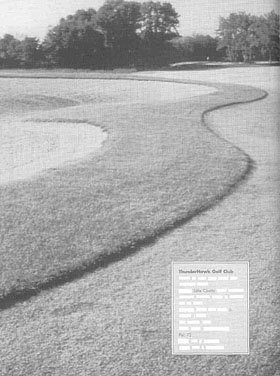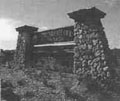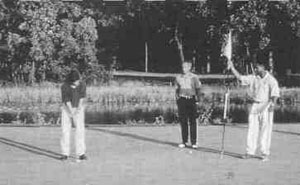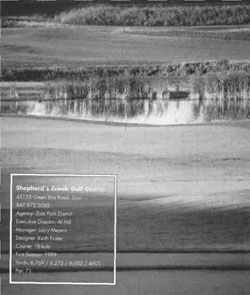 |
Home | Search | Browse | About IPO | Staff | Links |
 |
Home | Search | Browse | About IPO | Staff | Links |
 ThunderHawk Golf Club 39700 N. Lewis Ave., Beach Park 847.872.HAWK Agency: Lake County Forest Preserves Executive Director: Steven K. Messerli Pro: Bill Pantle Designer: Robert Trent Jones, Jr. Course: 18-hole First Season: 1999 Yards: 7,031 /6,631/5,046 Par: 72 Slope: 136 / 132/122 Rating: 73.8 / 71.9/69.2 16 * Illinois Parks and Recreation * March / April 2000 SPECIAL FOCUS SPECIAL FOCUS 
New Kids on the Block Introducing ThunderHawk and Shepherd's Crook! Located about a mile a part in Lake County, they are Illinois' newest forest preserve and park district courses. BY KIM DRUMMOND AND CRAIG E. PETERSON ThunderHawk Nestled in northeastern Illinois near the communities of Beach Park and Zion, this scenic and challenging 18-hole public championship course was designed by legendary golf course architect Robert Trent Jones, Jr. It features 243 acres of rolling terrain that boast more than 32 acres of restored wetlands, 74 acres of new and transplanted woodlands and 57 acres of reintroduced native prairie. Golf course superintendent Mark Petitgoue—one of nine national public golf course superintendents recently named an Environmental Steward Award winner by the Golf Course Superintendents Association of America—asserts that more than 67 percent of this property is a refuge for plants, fish and wildlife. For its commitment to the environment, ThunderHawk is expected to be only the sixth public golf course worldwide to achieve the prestigious Audubon Signature designation. ThunderHawk's environmental commitment ensures the site's natural resources are preserved, restored and enhanced for future generations to come.
Inspired by Nature Sensitive management practices designed to maximize the protection of natural resources are at the heart of ThunderHawk's natural resource management plan. Practices include minimal use of fertilizers and pesticides, water quality monitoring and conservation, and wildlife habitat enhancement. Plant materials at ThunderHawk are native and indigenous to the site. Native grasses such as switch-grass, Indian grass and big bluestem now grow here for the first time in decades. Fortuitously, ThunderHawk is also home to the state's largest population of small sundrops, a state threatened plant. During construction, the plant was discovered here, and, thanks to an extensive monitoring and management plan, now flourishes. Several golf holes were reconfigured and a split rail fence erected to protect the sundrops. Photo on page 16: Illinois Parks and Recreation * March/April 2000 * 17 SPECIAL FOCUS 

Photo at top: The view along hole 6 at ThunderHawk is enough to distract even the most disciplined golfer. Photograph by Pat Wadecki. Below: A state endangered plant, the small sundrop, thrives at ThunderHawk. Several holes were reconfigured and a split rail fence erected to ensure the sundrops' protection. Photograph by Kim Karpeles. Another sign of ThunderHawk's environmental quality is its dozen pristine wetlands and newly created six-acre lake, which provide excellent breeding, nesting and feeding ground for a variety of wildlife and waterfowl. Scattered groves of majestic oaks, ashes and hickories provide further proof that nature is undisturbed here. More than 450 transplanted trees and more than 500 new trees enhance ThunderHawk's aesthetic value and provide important habitat for wildlife.
Environmental Considerations Energy-saving principles were utilized in every aspect of ThunderHawk's operation, both indoors and outside. Some examples include: returning grass clippings to fairways; efficiently locating cart paths to help defray costs of fuel and labor and to minimize damage to fairways; selecting electric golf carts to avoid reliance on fossil fuel; and installing motion sensors, energy-saving lights and electronic programmable time clocks and photo cells in ThunderHawk's buildings. In addition, ThunderHawk supports an extensive recycling program that includes recycling everything from soil plugs to motor oils to merchandise packing. Use of recyclable products is also preferred. A Great Golf Layout Among the course's signature holes are 15 and 18. Hole 15 is 172-yard, par 3 that launches a golfer's tee shot through a cathedral of oaks over wetlands to a large, elevated green guarded by bunkers. And hole 18 is a breathtaking 600-yard, par 5 with a small bunkered green fronted by an impressive rock wall and accompanying wetlands. According to ThunderHawk's new general manager and PGA professional Bill Pantle, ThunderHawk is not too difficult for seniors or women, but all golfers will need a good short game to score well here. The Lodge at ThunderHawk Outings, Special Events With a tournament-ready course, ThunderHawk hosted two important golf tournaments in 1999. The IPGA (Illinois Professional Golfers Association) Qualifying Tournament for Illinois occurred in June followed by the a qualifying tournament for the Oldsmobile National Scramble in August. What They're Saying 18 * Illinois Parks and Recreation * March / April 2000 facilities, and Golf Chicago writer Greg Miles likened ThunderHawk to golfer "heaven." Recently, ThunderHawk was named by Golf Magazine as "one of the top new public golf courses in the country" and was listed in the magazine's "100 Greatest Golf Courses You Can Play" and received Honorable Mention for Golf Digest's 1999 Environmental Leaders Award. Such laurels contributed to a banner year for the entire Lake County Forest Preserve District, which was named the 1999 Grand Award Winner in the National Recreation and Park Association's Gold Medal competition. KIM DRUMMOND Shepherd's Crook  Shepherd's Crook Golf Course 43125 Green Bay Road, Zion 847.872.2080 Agency: Zion Park District Executive Director: Al Hill Manager: Larry Meyers Designer: Keith Foster Course: 18-hole First Season: 1999 Yards: 6,769 / 6,272 / 6,002 / 4901 Par: 71 Return to the roots of golf at Shepherd's Crook, the Zion Park District's new championship layout that offers a passage back to golfs heritage. Shepherd's Crook is a step back in time and place, with a name befitting Zion's origin as a religious theocracy. Its design is characteristic of the ancestral links courses of Ireland or Scotland, the native country of Zion founder John Alexander Dowie. Shepherd's Crook gives you a sense of being transported to the gently rolling countryside in the kingdom across the big pond. The links-style layout, which creates a feeling of playing Ballybunnion or Waterville in Ireland, was designed by Keith Foster, an architect with a growing reputation in the field of golf architecture. Foster used his considerable skills to carve out Shepherd's Crook from farm land bordering a sanitary landfill. The landfill operator originally planned a large expansion on the land, but that plan was opposed by local and county governments, resident neighbors and environmental groups. After years of intergovernmental and commercial negotiations on the fate of the site, an agreement provided for a scaled-back expansion in exchange for donating and developing the remaining land into a golf course funded by revenue from the landfill facility. The area was primarily farm land before industry came and is a mixture of rolling hills with gentle slopes contrasted with a patch of woodlands in the center and wetlands sprinkled throughout. The scene harkens back to an even earlier stage in history, when the area was a mix of prairie, woods and wetlands. Shepherd's Crook gives you a welcoming handshake with the opening three holes: 350-yard Short Fuse, 378-yard Whistling Winds and 346-yard Eye of the Needle. The trio run parallel to each other and gives the golfer the effect of being directed into the heart of the course. Then it becomes more demanding. At the fourth hole, the handshake is over. Shepherd's Crook strikes with a hole aptly named Here We Go. At 245 yards from the Illinois Parks and Recreation * March/April 2000 * 19 NEW KIDS ON THE BLOCK tips, it'll be one of the longest par-3's you'll ever play. You need another big tee shot at the fifth hole, Cathedral, which at 427 yards is the longest par-4 and is named for the effect of hitting an approach into a "cathedral" of oak trees. The sixth tee at Marsh Mellow, is positioned under a canopy of trees and faces a marsh requiring a carry of at least 180 yards. The seventh, Surf and Turf, features a split fairway, offering a longer but safer shot to the green on the high fork and a shorter and riskier approach from the low fork. The par-3 eighth hole called Shepherd's Hollow is cut out of a mature stand of trees, and the sudden contrast of being "inside" the hollow creates an illusion that the hole is shorter than it really is. And, if the wind is coming from the east, it can change the illusion into a reality. The front nine's finishing hole and its lone par-5 imposes a battery of mental challenges once you get off the tee. A center bunker is the signpost for Snake Bite, which features another split fairway offering multiple sets of risk vs. reward options and an approach over a ravine to an elevated green. The tricky, tiered 10th green at Morning Glory demands a high, soft and precise shot beyond its false front. The 11th, Shepherd's Haven, is a long sloping par-3 that can be played a couple different ways from the tee. Shotmakers are offered a great opportunity to test their skills at the 12th hole, Blind Draw, which features a split fairway offering two very different approaches. Go left and you've got a shorter, blind approach. Go right and you have a longer approach with a great view and a less-obstructed angle to the green. The Farm is the background of the approach of the 409-yard 13th, a mere prelude to the longest hole in Lake County, Illinois. The 14th, a 654-yard stretch of golf known simply as Brute. A diagonal creek comes into play on the second shot, and the dilemma becomes: Do you lay up on the short side and leave yourself a 200-plus third, or do you hit a 200-plus fairway wood to clear it? It is Shepherd's Crook's moment of truth. Shepherd's Crook eases up a bit but keeps the pressure on with sporty holes called Straight and Narrow, an uphill 15th hole to a crowned green; Watering Hole, a downhill par-3 with water lurking left and long; and Shepherd's Crook at the 17th, a sharp dogleg left with the green nestled within a pocket of tall trees. Shepherd's Crook throws everything at you on its finishing hole, a 570-yard double dogleg featuring a split fairway, a special shortcut for long hitters, slanting fairway terrain, blind layup short, diagonal drainage ditch in a landing area and a rock wall protecting a false front of the elevated green. Devil's Ditch is the ultimate shotmaker's hole. In addition to varied hole designs and fairway layouts, prairie grass rough that can be punishing and changes in terrains, Foster's design includes assorted green defence and green designs. Hitting greens and putting on them are challenging but not unnerving. While the 6,769-yard layout is not overwhelming, Shepherd's Crook is sneaky long in some places, with several shots requiring length off the tee. The four par-3's average 193 yards in length. In addition to a challenging design, the course's layout has a natural flow to each hole, without signage, ropes or fencing obstructing the natural look of the site. Your green fee pays for golf value at Shepherd's Crook, not unnecessary amenities. Featuring four sets of tees, the course can be played to a wide variety of skill levels. Shepherd's Crook can still be played by golfers with limited shotmaking skills, but shotmaking pays off with rewards. You might not be able to golf the links at Ballybunnion or Waterville in person, but you can tour them in spirit by booking passage for a virtual tour of golfs heritage at Zion Park District's Shepherd's Crook.
Photo on page 19: Hole 16, appropriately named "Watering Hole," is a challenging, downhill par-3. Photograph by Zion Park District staff.
CRAIG E. PETERSON Illinois Parks and Recreation * March/April 2000 * 21 |
|
Sam S. Manivong, Illinois Periodicals Online Coordinator |